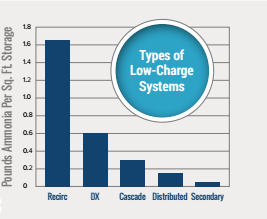After months of discussions and hours of negotiations, nearly 200 nations have now reached a deal to limit the use of greenhouse gases worldwide. In October, world leaders agreed to the deal that would gradually phase out the use of hydrofluorocarbons (HFCs) starting in 2019.
HFCs, such as R22 and R134A, are common refrigerants that will be phased out soon. As a result, users are turning to low-charge packaged refrigeration systems, which utilize natural refrigerants. Why? These low-charge chillers use ammonia or CO2 and a secondary refrigerant to provide an environmentally friendly system, which is also much safer than traditional ammonia systems of the past.
I’ve outlined the benefits of using low-charge packaged refrigeration equipment in a previous post. However, there are many different types of these systems. The system best fit for your facility is dependent on how many tons of refrigeration you need and at what temperature. (If you’re unsure, reach out to your packaged refrigeration equipment provider for clarification.)
Below are the five common types of low-charge packaged refrigeration systems:
-
Recirculated system—A recirculated system utilizes a centralized refrigeration machine room where pumps recirculate expanded, cooled liquid from a vessel. Typically, excess liquid refrigerant is provided to the evaporators (cooling coils) to increase heat transfer in the evaporators. If there is excess liquid fed to the evaporators (known as overfeed) it is carried back to the vessel in the suction line (known as wet suction).
-
Direct expansion (DX) system—A DX system uses the pressure differential provided by the refrigerant compressors to move room-temperature, high-pressure liquid from the centralized refrigeration machine room to the evaporators. The refrigerant is expanded, and therefore cooled, directly at the unit. Typically, the liquid is fed to the evaporator at a rate that allows the refrigerant to evaporate so there is typically no liquid found in the suction line (known as dry suction).
-
Cascade system—A cascade system uses a combination of two centralized refrigeration systems (secondary refrigerant) to work in unison to provide cooling to evaporators. The high-temperature refrigeration system (usually ammonia) pulls heat away from the lower-temperature refrigeration system. The lower-temperature refrigeration system (usually CO2) typically uses recirculated liquid to provide cooling to the evaporators.
-
Distributed system—A distributed refrigeration system uses localized refrigeration systems located near the evaporator to keep the refrigerant charge lower. Each evaporator has its own compressors and condensers.
-
Secondary system—A secondary refrigerant system uses a centralized refrigeration system to chill large amounts of a secondary coolant (also known as secondary brine or glycol). The secondary coolant is then pumped out to each air handling unit. Primary refrigerant does not leave the machine room, so the refrigerant charge is minimized and the risk of exposure to plant personnel is greatly reduced.
To learn more about low-charge packaged refrigeration systems, download our Packaged Refrigeration Equipment Buyer’s Guide.




